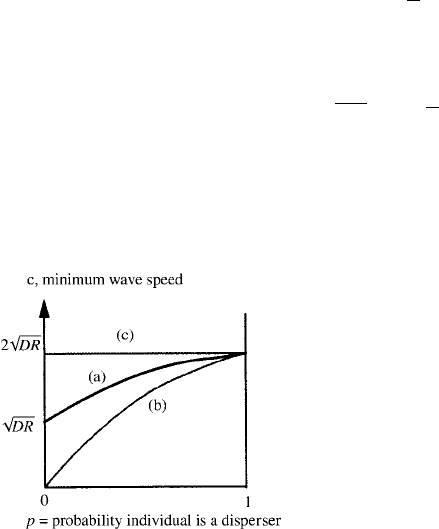Murray J.D. Mathematical Biology: I. An Introduction
Подождите немного. Документ загружается.


476 13. Biological Waves: Single-Species Models
What this implies is that small C, in this lower range, (0, 1 −
√
p), results in U and
V approaching the steady state along eigenvectors that have opposite signs and so this
does not consitute a realistic (nonnegative) solution for both U and V . Hence we can
conclude that for very small C there are no eigenvectors that correspond to meaningful
travelling wave solutions. But, as C increases through the range (0, C
1
) in (13.107), the
eigenvalues and the eigenvectors change continuously. For a realistic solution, one of
the first two components of an eigenvector would have to pass through zero. But we can
see that there are no nontrivial solutions to (13.109) with either e
1
= 0ore
2
= 0. So,
from continuity arguments we can say that there is no ecologically realistic travelling
wave solution for wavespeeds, C, in the lower range (0, C
1
).
It is pedagogically useful to carry out a similar analysis for C in the higher range
(1 +
√
p, ∞) in (13.107). Here we expand the eigenvalues for large C, and get
λ
1
=−
1
C
+ O
1
C
3
,λ
2
=−C +
p
C
+ O
1
C
3
. (13.110)
In this case, going through a similar argument, both corresponding eigenvectors have U-
and V-components with matching signs. (Remember that the eigenvector corresponding
to λ
0
= 0 is not admissible.) We can therefore conclude that it is only for wavespeeds,
C, in the higher range of C-values that admissible solution trajectories exist. The major
consequence of this is that the wavespeed C
2
= 1 +
√
p is the lower bound on the
wavespeed for realistic solutions; this corresponds to the minimum wavespeed, namely,
2
√
RD in dimensional terms, for the Fisher–Kolmogoroff equation (13.13) in the stan-
dard analysis. We come back to this below and discuss its importance and relevance to
species invasion.
Relative Sizes of Subpopulations
Travelling waves are in effect population growth waves so, even though it is the dis-
persers that are responsible for the wave propagation, at any position on it there is
growth of the nondispersers as well as the dispersers according to (13.94). We can de-
termine the relative size of the dispersing and nondispersing subpopulations along the
travelling wave solution by exploiting the form of the equations. The 3-variable system
(13.99) and (13.100) with W = U
Z
can be decoupled as a consequence of the particular
form of the nonlinear terms. If we write
Q = U + V, U
Z
= P, (13.111)
that is, Q is the total population, the system becomes
U
Z
= P, P
Z
=−CP− pQ(1 − Q),
Q
Z
= P −(1 − p)Q(1 − Q)/C,
(13.112)
so we can analyse the P − Q plane as we have just done above except that, here, the
eigenvector arguments are based on Q being positive while P is negative at (0, 0).
Using this formulation we can decide the issue by determining which of the equilibria
(U, P, Q) = (U
0
, 0, 1) is the source for the heteroclinic orbit that terminates at (0, 0, 0).

13.7 Invasion Wavespeeds with Dispersive Variability 477
The actual shape of the projection of the trajectory we want onto the P − Q plane
is given by the solution of
dP
dQ
=
−CP− pQ(1 − Q)
P −(1 − p)Q(1 − Q)/C
. (13.113)
The change in U over this trajectory, that is, moving ‘back’ up the trajectory, must be
U
0
=
1
0
dU
dQ
dQ =
1
0
PdQ
P −(1 − p)Q(1 − Q)/C
. (13.114)
The upper limit on the integral, Q = 1, is because Q is the total (normalised) popula-
tion. To evaluate the integral we note that
dP
dQ
=
−CP− pQ(1 − Q)
P −(1 − p)Q(1 − Q)/C
=
pC
1 − p
−
C
1 − p
P
P −(1 − p)Q(1 − Q)/C
(13.115)
which can be rewritten as
P
P −(1 − p)Q(1 − Q)/C
= p −
(1 − p)
C
dP
dQ
. (13.116)
Using this we can now evaluate the integral for U
0
as
U
0
=
1
0
p −
(1 − p)
C
dP
dQ
dQ = p. (13.117)
So, what this says is that for any wavespeed, C,thevalueofU at Z =−∞must be p
with U(∞) = 0. In other words, far behind the wavefront the proportion of dispersers
is p; this is as we would have expected intuitively.
We can go further since, using the last equation with Q as the upper limit on the
integral,
U(Q) =
Q
0
dU
dQ
dQ = pQ − (1 − p)
P
C
(13.118)
which says that for any value of the total population, Q, the fraction of dispersers is
U
Q
= p −
1 − p
C
P
Q
, (13.119)
where P, recall, is the gradient of dispersers U
Z
.SinceP is negative the fraction of
dispersers is therefore higher than p at all points except at the limits where P = 0. The
proportion of dispersers is higher as we approach the front of the wave (as P becomes
more negative), again as we would expect.

478 13. Biological Waves: Single-Species Models
We can exploit the decoupled system further to look at the gradient of trajectories as
they approach (0, 0, 0). Based on (13.113), and using l’H
ˆ
opital’s rule, we can generate
a quadratic for dP/dQ at Q = 0(whereP = 0 also), namely,
dP
dQ
2
+[C −(1 − p)/C]
dP
dQ
+ p = 0. (13.120)
Since we must have (dP/dQ)<0 this requires
C >
1 − p. (13.121)
ButthisistrueforallC in the upper range, namely, (C
2
, ∞), and none in the lower
range (0, C
1
). So, the above result for admissibility of the wavespeeds C is confirmed.
Cook (Julian Cook, personal communication 1994) solved (13.97) numerically
and found that the solutions converged rapidly to a travelling wave solution with a
wavespeed very close to the predicted minimum speed. For example, if fraction of dis-
persing population p = 1.0, 0.5, 0.1, 0.05, 0.01 the theoretical minimum wavespeeds
are respectively 1+
√
p = 2.00, 1.70, 1.33, 1.22, 1.10 and the corresponding numerical
wavespeeds are 2.01, 1.77, 1.34, 1.22, 1.10.
13.8 Species Invasion and Range Expansion
The spatial spread of species is extremely important ecologically. The classic book by
Elton (1958) lists numerous examples and there are many others documented since then.
The killer bee invasion from Brazil up into the southwest of the U.S.A. is a relatively
recent dramatic one with the spread of the American bull frog in the south of Vancou-
ver Island an even more recent one. The seminal paper by Skellam (1951) essentially
initiated the theoretical approach. He used what is in effect the linearised form of the
Fisher–Kolmogoroff equation (13.4) which involves diffusion and Malthusian growth,
that is, exponential, growth. Among other things he was particularly interested in mod-
elling the range expansion of the muskrat and found that the wavespeed of the invasion
was approximately 2
√
rD,wherer and D are the usual growth rate and diffusion pa-
rameters. He further showed that the range expanded linearly with time; see the analysis
below where we derive this result. Shigesada and Kawasaki (1997), in their book, dis-
cuss a variety of specific invasions such as mammals, plants, insects, epidemics and so
on. They present some of the major models that have been proposed for such invasions
with the model mechanisms determined by a variety of factors related to the species’ ac-
tual movement and interaction. They study invasions, many of the travelling wave type,
in both homogeneous and heterogeneous spatial environments and for several different
species interactions such as predator–prey and competition.
Basically when the scale of the individual’s movement is small compared with the
scale of the observations a continuum model is a reasonable one with which to start. A
very good example where the model and data have been well combined is with the rein-
vasion along the Californian coast by the California sea otter (Enhydra lutris). Lubina
and Levin (1988) used the Fisher–Komogoroff equation (13.4) with the extant data.

13.8 Species Invasion and Range Expansion 479
The otter population was in serious decline through overhunting and was thought to
be almost extinct in the early 1900’s. It was protected by international treaty in 1911
but was thought to be already extinct. A small number (about 50) was found in 1914
near Big Sur and since that time the population has increased along with their territory
both north and south of Big Sur. One of the interesting aspects of this reinvasion, fully
documented by Lubina and Levin (1988), is that it is essentially a one-dimensional phe-
nomenon. They were able to estimate the parameters in (13.4) and show that the basic
velocity of the travelling wave, given by 2(rD)
1/2
,wherer and D are again the linear
growth rate and diffusion coefficient, gave excellent results. With a constant velocity
the growth of the range is linear with time as they demonstrate is indeed essentially the
case from the reinvasion data gathered over a period roughly from 1938 until 1984. This
is in line with the results obtained by Skellam (1951) for the muskrat spread. For the
northern invasion they obtained a value D = 13.5km
2
/yr and for the southern invasion
D = 54.7km
2
/yr with estimated population growth r = 0.056/yr which resulted in
wavespeeds of 1.74 km/yr and 3.4 km/yr for the north and south respectively. These
values compare with the observed values of 1.4 km/yr and 3.1 km/yr between 1938
and 1972 and for the southern rate of 3.8 km/yr for the period 1973 to 1980. They ar-
gue persuasively that the difference between the north and south invasion speeds is not
convection in the equation but rather habitat-changes in the parameters.
Let us now return to the results derived in the last section for the variable dispersion
model and consider them in the light of species territorial invasion. We have shown that
for the system (13.97) to have ecologically realistic, that is, nonnegative, travelling wave
solutions of the form given in (13.98) the wavespeed, C, must satisfy
C ≥ C
2
= 1 +
√
p, (13.122)
where p, given by (13.96), is the probability of a newborn individual being a disperser.
In dimensional terms we then have
c ≥ c
2
=
√
RD(1 +
√
p), (13.123)
where c is the dimensional speed of the travelling wave, D is the diffusion rate of the
dispersing subpopulation and R is the intrinsic rate of growth. Figure 13.14 gives the
minimum wavespeeds as a function of the probability of an individual being a disperser
and compares them with the classical Fisher–Kolmogoroff result.
Figure 13.14. Minimum dimensional speed c of a
travelling wave solution of (13.97) as a function of the
probability, p, that an individual is a disperser in a
population of dispersers and nondispersers. (a) Minimum
wavespeed for a fixed dispersal coefficient and fixed total
rate of growth from (13.123); note the finite speed as
p → 0. (b) The minimum wavespeed which is predicted
if the mean dispersal rate is used with the
Fisher–Kolmogoroff result. (c) The standard
Fisher–Kolmogoroff wavespeed if the total population
disperses with the same dispersal coefficient.

480 13. Biological Waves: Single-Species Models
Of course we have not proved that this travelling wave solution results from some
initial conditions such as was done by Kolmogoroff et al. (1937) for the Fisher–Kolmo-
goroff equation. But, I would be astonished if a solution with a minimum wavespeed
(13.123) did not result from convergence from reasonable initial conditions as it does
for the Fisher–Kolmogoroff equation.
Let us now consider two special cases, namely, p = 1andp 1.
(i) p = 1. Here all individuals disperse with the same diffusion coefficient and the
system reduces to the Fisher–Kolmogoroff equation with the usual lower bound
of c
2
= 2
√
DR for the wavespeed; this is the same as obtained from (13.123) as
p → 1.
(ii) p 1. In this situation very few individuals disperse. If we let p decrease but
keep D fixed the lower bound for the wavespeed from (13.123) is then c
2
∼
√
RD[1 +0( p
1/2
)]. This is exactly half the lower bound for the case in which all
individuals disperse at this fixed rate, D. This is an initially counterintuitive result
(see also Figure 13.14), namely, that wavespeeds for populations with only a very
few dispersive individuals are not greatly different—a factor of two at most—from
those in which all individuals disperse at the same rate. Natural environmental fac-
tors could easily have this effect.
The initial intuitive result is that if there are very few dispersers in a population
the invasion would be very small and in the limit zero. Of course when the number of
dispersers becomes very low the continuous diffusion assumptions are no longer valid
and stochastic effects would become dominant. Nevertheless even before we get to this
situation the wavespeed is still not close to zero.
Perhaps the main point of the Cook model and its analysis is that only a few dis-
persers can drive the invasion with a speed not very different to that if the whole pop-
ulation were dispersers. This clearly has important ecological implications. As pointed
out in the last section, waves of invasion are in effect waves of reproduction since as
soon as the population is greater than zero the reproductive terms in the model come
into play and these produce dispersers as well as nondispersers. We can think of fast
disperers as seeding the reproduction of the immobile nondisperers; in other words they
are the driving force in the reproduction wave.
Cook (Julian Cook, personal communication 1994) investigated several other as-
pects and modifications of his model, such as examining the consequences on the inva-
sion wave as a result of dispersal rate variance, an Allee effect in the population growth
(which means there is a minimum viable population; recall the discussion in Chapter 1)
and the effect of having both populations disperse but at different rates. He also carried
out extensive numerical simulations to confirm the analytical results and applied the
basic conept to other equations which model movement using some correlated random
walks and showed that his main result for the wavespeed is not confined to classical
diffusion models.
The work of Lewis and Schmitz (1996) is directly related to that by Cook (Ju-
lian Cook, personal communication 1994). They also consider biological invasion of
an organism with separate mobile and stationary states (they include the possibility of
switching between states) for both dispersal and reproduction. They show that rapid
invasion can occur even when transfer rates are infinitesimally small.

13.8 Species Invasion and Range Expansion 481
The paper by Shigesada et al. (1995) is particularly relevant to the question of vari-
able dispersion and invasion of species (see also the book by Shigesada and Kawasaki
1997). They considered the range expansion of several species such as the English spar-
row, the European starling in the U.S. and the rice water weevil in Japan. To study
range expansion one of the models they used is the scalar linearised form of the Fisher–
Kolmogoroff equation in two space dimensions, which is the one proposed by Skellam
(1951) in his classic work on dispersal. So, they considered the growth to be Malthu-
sian, that is, exponential. They started with the dimensional equation in the following
form,
∂u
∂t
=
2
u +εu, (13.124)
where u is the local population density and the space is radially symmetric. The solution
with a δ-function initial condition u(r, 0) = N
0
δ(r), representing a local introduction
of the species at the origin, is given by
u(r, t) =
N
0
4π Dt
exp
εt −
r
2
4Dt
. (13.125)
From the point of view of the spatial spread of the species in practice, the range of
expansion is effected by the invasion of a few individuals. So, as suggested by Shigesada
et al. (1995), there could be a minimum density below which the population cannot be
detected in practice. This suggests there is a de facto waiting period before a newly
introduced species starts to expand its habitat range. If this detectable population density
is denoted by u
∗
then the area where u(r, t)>n
∗
is defined as the range. From the
solution, (13.125), the population density u near the origin for small t very quickly drops
below the threshold u
∗
. However, because of the exponential growth term in (13.124),
which gives the εt in the solution, u starts to increase and eventually passes through
the threshold u
∗
. The lag period or establishment phase is the time between when the
population is introduced and its size passes through the threshold level. We can now use
the solution (13.125) to determine how the range increases with time by setting u = u
∗
and r = r
∗
to obtain
r
∗
= 2t
εD +
D
t
ln
4π Dtu
∗
N
0
1/2
. (13.126)
If we introduce dimensionless quantities by setting
R
∗
=
ε
D
1/2
r
∗
, T = εt,γ=
εN
0
Dn
∗
, (13.127)
we get the dimensionless R
∗
− T range–time relation
R
∗
= 2T
1 +
1
T
ln
γ
4π T
1/2
, (13.128)

482 13. Biological Waves: Single-Species Models
which depends only on the dimensionless parameter γ .When(1/T ) ln(γ /4π T ) 1
the range expands linearly with time according to R
∗
≈ 2T .
Shigesada et al. (1995) go on to develop a model of species invasion and range
expansion with scattered colonies which are initiated by long range dispersers. Such
models are in effect invasion models with variable diffusion. Importantly they relate
their analytical results to real data and obtain a good correlation.
The idea of using a threshold and radially symmetric linear diffusion reaction to
give rise to an invading front was used by Murray (1981) in a completely different bi-
ological application, namely, the development of eyespots on butterfly wings. He also
applied the model to other, nonradially symmetric situations. This application is de-
scribed in detail in Chapter 3, Volume II.
Exercises
1 Consider the dimensionless reaction diffusion equation
u
t
= u
2
(1 − u) + u
xx
.
Obtain the ordinary differential equation for the travelling wave solution with u(x, t) =
U(z), z = x − ct,wherec is the wavespeed. Assume a nonnegative monotone so-
lution for U(z) exists with U(−∞) = 1, U(∞) = 0 for a wavespeed such that
0 < 1/c = ε
1/2
where ε is sufficiently small to justify seeking asymptotic solutions
for 0 <ε 1. With ξ = ε
1/2
z, U(z) = g(ξ ) show that the O(1) asymptotic
solution such that g(0) = 1/2 is given explicitly by
ξ =−2 +
1
g(ξ)
+ln
1 − g(ξ)
g(ξ)
,ξ=
x −ct
c
.
Derive the (V, U) phase plane equation for travelling wave solutions where V =
U
and where the prime denotes differentiation with respect to z. By setting φ =
V/ε
1/2
in the equation obtain the asymptotic solution, up to O(ε),forφ as a function
of U as a Taylor series in ε. Hence show that the slope of the wave where U = 1/2
is given to O(ε) by −((1/8c) +(1/2
5
c
3
)).
2 Show that an exact travelling wave solution exists for the scalar reaction diffusion
equation
∂u
∂t
= u
q+1
(1 −u
q
) +
∂
2
u
∂x
2
,
where q > 0, by looking for solutions in the form
u(x, t) = U(z) =
1
(1 + de
bz
)
s
, z = x −ct,
where c is the wavespeed and b and s are positive constants. Determine the unique
values for c, b and s in terms of q. Choose a value for d such that the magnitude of
the wave’s gradient is at its maximum at z = 0.

Exercises 483
3 An invasion model with variable subpopulation dispersal is given in dimensionless
form by
∂u
∂T
=
∂
2
u
∂ X
2
+ p(u +v)[1 −(u +v)],
∂v
∂T
= (1 − p)(u + v)[1 − (u + v)],
where u and v represent the dispersers and nondispersers respectively and p is the
probability that a newborn individual is a disperser. Look for travelling wave solu-
tions with Z = X −CT and derive the travelling wave system of ordinary differential
equations. Introduce
ε = 1/C
2
, s = Z/C, u(Z) = g(s), v(Z) = h(s)
and then show that the travelling wave system becomes
εg
ss
+ g
s
+ p(g + h)[1 −(g + h)]=0,
h
s
+(1 − p)(g +h)[1 − (g + h)]=0.
Although C
min
= 1 +
√
p, with p ≤ 1 the parameter ε is not small if p is near 1,
consider ε small and look for a regular perturbation solution to this system in the
form
g = g
0
+εg
1
+···, h = h
0
+εh
1
+···.
Justify using the boundary conditions
(g
0
+h
0
) |
−∞
= 1,(g
0
+h
0
) |
∞
= 0,(g
0
+h
0
) |
0
= 1/2,
g
i
|
±∞
= h
i
|
±∞
= 0, i > 0.
Derive the system of equations for g
0
and h
0
. By setting y
0
= g
0
+ h
0
,which
corresponds to the total population to O(1), obtain an equation for y
0
and give the
conditions it must satisfy at ±∞ and s = 0 and hence determine the solution y
0
(s).
Show that
d
ds
[(1 − p)g
0
− ph
0
]=0
and use it together with the definition of y
0
to solve for g
0
. Hence determine the
travelling wave solution for u(Z;C) and v(Z;C) to O(1) for large C
2
.
Construct a model with a more general nonlinear reproduction kinetics and
investigate whether or not you can carry out a similar analysis.
14. Use and Abuse of Fractals
14.1 Fractals: Basic Concepts and Biological Relevance
The problem with a good name for a new (or resurrected) field, particularly one such as
fractal theory which can be visually dramatic and practised without much background
and sophistication, is that uninformed proselytising and inappropriate use can raise un-
realistic expectations as to its relevance and applicability. Catastrophe theory is another
example: its overzealous mathematical practitioners did considerable harm to the cause
of interdisciplinary science. Although chaos and fractal theory have been proposed by
some as biological panaceas fortunately there are enough realists to counter this view
and generally keep them in perspective.
A particular and widespread misconception about fractal theory arises because it
can create objects which look remarkably like many natural structures such as trees,
weeds, flowers, butterfly wing patterns and so on, and this is often taken to be a biolog-
ical explanation of how these structures and patterns are formed. Although fractal-like
patterns may be reasonable graphical representations of such natural shapes they say
essentially nothing about the biological processes and mechanisms which are involved
in their development. Considerably more is required of a model. Notwithstanding this
criticism, fractal ideas can, and have been, very helpful.
One of the applications of fractal theory is directly related to the measurement of
biological structures at different magnifications; it is one that we discuss in this brief in-
troduction to fractal theory. We can think of fractals in a simplistic, but still useful, way
as geometric figures which repeat themselves at progressively smaller scales or exhibit
progressively more complex structure when observed at larger and larger magnifica-
tions. With a fractal there is often self-symmetry, or approximate self-symmetry. That
is, if we magnify a small part of the overall pattern it more or less displays some aspects
of the whole pattern. There are now many books on the subject; these often include dis-
cussions of chaos, a closely related subject. The comprehensive book by Peitgen et al.
(1992) is full of relevant matter and historical detail (but with no practical biological ex-
amples); the mathematical level is reasonably elementary but still nontrivial. The book
by Liebovitch (1998) gives a very simplified, elementary and clear exposition specif-
ically oriented towards the life sciences; there are many examples discussed in detail.
The book by Strogatz (1994) is more mathematical but it has some more applications
to biology; it primarily deals with chaos. The book by Bassingthwaighte et al. (1994) is
specifically devoted to physiological problems; it also gives basic background material
14.1 Fractals: Basic Concepts and Biological Relevance 485
on fractals (and chaos). The book by Falconer (1990) is a clear introduction to the theory
and applications of fractals generally. The visually beautiful book by Kaandorp (1994)
exploits new computer techniques to simulate fractal modelling (in both two and three
dimensions) in a wide variety of biological growth situations, such as coral colonies.
His approach is different from that in which the possible mechanism is the starting
point. He introduces elements in his models to simulate slow changes in environmental
conditions and so on. This approach coupled to a mechanistic one could produce some
interesting new biological insights: in Kaandorp et al. (1996), for example, he suggests
how to include the effect of nutrient diffusion and flow on coral morphology.
The labelling as fractal of a spectrum of growth phenomena which can be phe-
nomenologically described by some kind of power law over a long time is highly
controversial—witness the article in Science by Avnir et al. (1998) and the subsequent
fairly aggressive letters in the following issues. The hypotheses which have been pro-
posed as a result of applying (rightly or wrongly) fractal theory to natural phenomena in
many ways emphasises the necessity of studying and, hopefully, determining the actual
mechanisms involved in a growth process and reflects a major view espoused through-
out this book, namely, that phenomenological descriptions are not explanations even
though they can be helpful in limiting what is and what is not possible in the develop-
mental process.
To motivate the study of fractals let us consider a real biological problem (in fact
a class of them) and show why we need fractal theory to deal with it. In the following
sections we discuss some simple examples of fractals and how to generate them to
highlight some of their essential properties to get the basic ideas of what a fractal and
a fractal dimension are. In Section 14.3 we return to the biological problem we started
with and show how to use these concepts practically. We shall also briefly raise some
caveats about fractals and biology in general. This very brief introduction should be
sufficient to follow or appreciate most of the applications of fractal ideas and concepts
to real biological problems—and hopefully be able to distinguish between the relevant
and the irrelevant of which there are many.
Biological Examples
Analysis of Retinal Cell Branching and Coverage. The morphoglogy and branching
characteristics of neuronal cells have been widely studied with a view to understanding
shape morphogenesis, territorial coverage, classification and so on. Such studies fre-
quently involve a detailed analysis of different cell types and various methods have
been developed to address specific metric questions. For example, are specific types of
ganglion cells scale invariant? In other words are they fractal? Famiglietti (1992) inves-
tigated the similarities and differences in directionally selective retinal ganglion cells
of the rabbit and proposed a fractal approach and carried out such an analysis. Freed
and Sterling (1988) studied alpha ganglion cells of the cat retina; Figure 14.1(a) is a
typical example of the type of cellular structure which has to be examined. Tauchi and
Masland (1984) and Tauchi et al. (1992) studied the shape and arrangement of specific
neuronal cells in the rabbit retina; Figure 14.1(b) is a typical example of the structure
of such cells. Montague and Friedlander (1991) studied the morphogenesis and spatial
